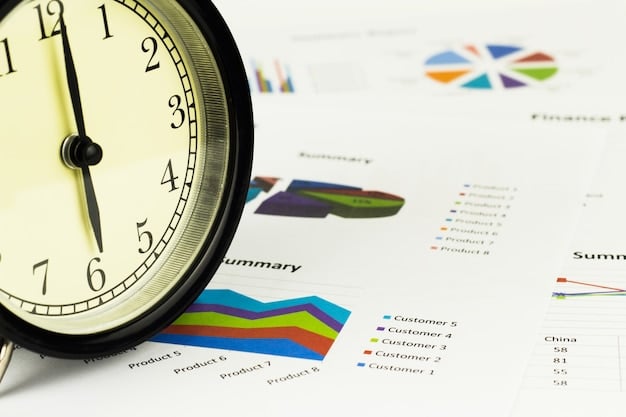Optimize Your Time: Time-Tracking Software Guide 2025

Optimize Your Time: Leveraging time-tracking software to identify and eliminate time-wasting activities can significantly boost productivity, providing insights into how time is spent and enabling data-driven decisions to streamline workflows and enhance focus.
Are you feeling like you’re constantly running out of time? Wondering where your day goes? The key to reclaiming control and boosting productivity might just lie in effectively using time-tracking software. Let’s explore how you can **optimize your time** by identifying and eliminating time-wasting activities using these powerful tools.
Understanding the Power of Time Tracking for Enhanced Productivity
Time tracking is more than just a record of your workday; it’s a powerful tool that provides actionable insights into your habits and productivity patterns. By understanding where your time actually goes, you can identify areas where you’re losing valuable minutes or hours.
Effective time management begins with awareness. Time tracking software brings this awareness to the forefront, allowing you to see exactly how much time you spend on different tasks, projects, and activities. This clarity is the first step towards making meaningful changes and improving your overall efficiency.
Why Time Tracking Matters for Productivity
Time tracking matters immensely for productivity because it provides concrete data about how your time is spent. Without this data, it’s easy to overestimate or underestimate the time spent on specific tasks, leading to inefficiencies and wasted effort.
- Pinpointing Time Wasters: Identifies activities consuming excessive time without significant return.
- Improving Task Estimation: Enhances accuracy in predicting task completion times, aiding project planning.
- Enhancing Focus & Concentration: Promotes staying on task, reducing distractions and improving time on task.
- Boosting Accountability: Encourages mindful use of time and a commitment to higher productivity.
By utilizing time tracking, individuals and teams can make data-driven decisions to optimize workflows, reduce distractions, and improve overall project management. This leads to greater efficiency, increased output, and a better work-life balance.

Choosing the Right Time-Tracking Software for Your Needs
Selecting the appropriate time-tracking software is crucial for effectively managing your time and enhancing productivity. With numerous options available, finding the perfect fit requires careful consideration of your specific needs and preferences.
The most effective software will seamlessly integrate into your workflow and provide the insights you need to make informed decisions about your time management strategies. Factors such as ease of use, integration capabilities, and reporting features should all be taken into account when making your selection.
Key Features to Consider
When choosing time-tracking software, there are several key features to consider to ensure it aligns with your specific needs and goals. These features can significantly impact the software’s usability and its effectiveness in helping you optimize your time.
- Ease of Use: An intuitive interface makes it easy to start and stop tracking, reducing friction in the process.
- Reporting and Analytics: Comprehensive reports offer insights into time allocation, progress tracking, and efficiency.
- Integration with Other Tools: Seamless integration with project management, accounting, and communication apps streamlines workflows.
- Mobile Accessibility: Mobile apps allow tracking on the go, capturing all time spent regardless of location.
Considering these features will help you choose a time-tracking solution that feels natural, integrates smoothly with your existing workflows, and ultimately enhances your productivity.
Setting Up Time-Tracking Software for Maximum Effectiveness
Once you’ve chosen the right time-tracking software, setting it up correctly is crucial for harnessing its full potential. Proper setup ensures accurate data collection and insightful reports that will drive meaningful changes in your time management habits.
Creating a clear and organized framework will enable you to track your time more effectively and gain a comprehensive understanding of how you allocate your resources. This setup process involves defining your projects, tasks, and categories to facilitate accurate tracking and analysis.
Step-by-Step Setup Guide
Setting up your time-tracking software effectively involves several crucial steps to ensure accurate data collection and insightful analysis. These steps ensure your software is tailored to your specific workflows and provides meaningful reports.
- Define Your Projects: Create clear categories for each of your ongoing projects.
- Break Down Tasks: Divide projects into smaller, manageable tasks for detailed tracking.
- Implement Clear Tagging: Use tags to categorize tasks by type, priority, or client.
By following these steps, you can set up your time-tracking software to accurately reflect your workday and provide valuable insights into your productivity habits.
Identifying Common Time-Wasting Activities Through Tracking
One of the most significant benefits of time-tracking software is its ability to pinpoint time-wasting activities that undermine your productivity. Recognizing these common culprits is the first step toward eliminating them and reclaiming control of your time.
Many individuals are unaware of how much time they lose to distractions, unproductive meetings, or poorly defined tasks. Time tracking sheds light on these hidden inefficiencies, revealing patterns that might otherwise go unnoticed.

Common Time Wasters Revealed by Time Tracking
Time-tracking software reveals common time wasters that significantly impact productivity. Understanding these pitfalls is crucial for implementing strategies to minimize their effect and reclaim valuable time.
- Excessive Meetings: Unproductive meetings that eat into valuable work time.
- Social Media Distractions: Time spent idly browsing social media platforms.
- Task Switching: Frequent switching between tasks that diminishes focus and efficiency.
- Poor Communication: Inefficient communication leading to misunderstandings and time delays.
By identifying and addressing these time wasters, individuals and teams can significantly enhance their productivity and achieve better outcomes.
Implementing Strategies to Eliminate Time Wasters
Once you’ve identified the time-wasting activities impacting your productivity, the next step is to implement strategies to eliminate or minimize their impact. Developing effective strategies can transform your workday, making it more focused and efficient.
Strategies for eliminating time wasters range from simple adjustments to more comprehensive changes in your workflow. The key is to find approaches that work for you and consistently apply them to reclaim your time and boost your productivity.
Effective Strategies for Time Management
Effective strategies for time management can help you eliminate time wasters and optimize your productivity. These techniques involve making conscious choices about how you allocate your time and focus your energy.
- Prioritization Techniques: Tools like the Eisenhower Matrix help focus on urgent and important tasks.
- Time Blocking: Dedicate specific blocks of time for particular tasks and activities.
- Eliminating Distractions: Minimize interruptions and create a focused work environment.
By implementing these strategies, you can create a more structured and productive workday, reducing the impact of time-wasting activities and achieving your goals more efficiently.
Best Practices for Continuous Time Optimization
Optimizing your time isn’t a one-time fix; it’s an ongoing process that requires continuous attention and refinement. Establishing best practices ensures that you’re consistently improving your time management skills and maximizing your productivity.
Regularly reviewing your time-tracking data, adjusting your strategies, and staying adaptable to changing circumstances are essential components of continuous time optimization. By embracing this proactive approach, you can maintain a high level of productivity and achieve your goals more effectively.
Maintaining Productivity Over Time
To maintain productivity over time, it’s essential to adopt best practices and continuously refine your time management strategies. These practices focus on adapting to change, monitoring progress, and making data-driven adjustments.
- Regularly Reviewing Data: Analyze time-tracking reports to identify new areas for improvement.
- Adapting to Change: Adjust strategies to align with evolving priorities and workflows.
- Tracking Progress: Monitor the impact of changes on productivity and efficiency.
By implementing these best practices, individuals and teams can sustain a high level of productivity and remain adaptable in a dynamic work environment.
| Key Point | Brief Description |
|---|---|
| ⏰ Identify Time Wasters | Use detailed reports to pinpoint where your time is being inefficiently spent. |
| 📊 Data-Driven Decisions | Inform strategies based on factual data from time tracking. |
| 📅 Time Blocking | Allocate specific time slots to different tasks to boost focus and minimize distractions. |
| 🎯 Prioritize Tasks | Use the Eisenhower Matrix or similar tools to determine the urgency and importance of tasks. |
Frequently Asked Questions
▼
Time-tracking software is a tool that allows you to record how you spend your time on different tasks and projects, providing insights into your productivity patterns.
▼
By identifying time-wasting activities and understanding how you allocate your time, you can make informed decisions to improve efficiency and focus.
▼
Common time wasters include excessive meetings, social media distractions, task switching, and poor communication, all of which can be identified with time-tracking tools.
▼
Consider factors like ease of use, reporting capabilities, integration with other tools, and mobile accessibility to find software that best fits your specific needs.
▼
Strategies include using prioritization techniques like the Eisenhower Matrix, time blocking, and minimizing distractions to create a more focused work environment.
Conclusion
In conclusion, time-tracking software is a valuable tool for anyone looking to optimize their time, boost productivity, and eliminate time-wasting activities. By understanding how you spend your time and implementing effective strategies, you can transform your workday and achieve your goals more efficiently.





